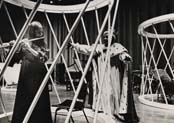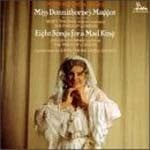OPERA SEARCH

Eight Songs for a Mad King
(1969)Text by Randolph Stow and George III (E,F,G)
fl(=picc).cl-perc(1): railway whistle/SD/2susp.cym/foot cyms/2wdbl/
BD/chains/ratchet/tom-t/tam-t/tamb/rototoms/toy bird-calls/2tpl.bl/
wind chimes/crot/sleigh bells/glsp/steel bars/crow/didgeridoo-
pft(=hpd,dulcimer)-vln.vlc
Abbreviations (PDF)
Boosey & Hawkes
Queen Elizabeth Hall, London
Roy Hart, voice
Conductor: Peter Maxwell Davies
Company: Pierrot Players
| KING | Baritone |
Long established as a classic of music-theatre, the work is an extravagant, disturbing and poignant portrayal of madness. The king is George III of England - or maybe another madman who believes himself to be that monarch - vocalizing weirdly as he bemoans his fate and tries to teach his instrumentalist-birds to sing. The string and woodwind players are the captives of his insanity, intended to play from within giant cages, while the percussionist is his keeper, holding him within the confines of a maddened musical sensibility. But all the musicians are essentially projections from within his own mind. The focus is always on him, and on his wild vocal performances, which include various kinds of Sprechgesang, chords and a range of over four octaves. The virtuosity of the instrumentalists is no less, nor that of the composer in playing spikily over a range of eighteenth-century references.
by Paul Griffiths
Dramatic, Poetic, Tragic

Julius Eastman, The Fires of London, Peter Maxwell Davies
Unicorn-Kanchana DKPCD9052
